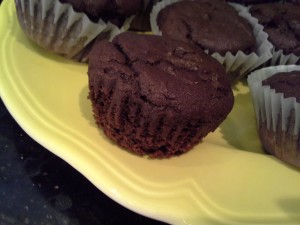Robo turned two a week ago. As is customary for birthdays, I made him a cake—well, it was actually cupcakes. But this was not an ordinary cake because, as most of you know, Robo is allergic to many of the things you would ordinarily put in a cake: wheat, dairy, eggs, and nuts. I didn’t make him a cake for his first birthday because we were traveling in Maryland that day (it was a nearly perfect day of chilling on the beach, eating crabs at a Chesapeake Bay crab shack for dinner, staying at an idyllic beach home, etc.), so he just had an Enjoy Life chocolate cookie with store-bought chocolate frosting on it (many store-bought frostings are dairy-free). So this was my first real foray into allergy-free cake baking.
Well, not exactly. I’ve been making what is usually called “wacky cake” or “depression Cake” for over a year. Since it has no dairy or eggs in it, all I have to do is substitute gluten-free flour for wheat flour, and I’m good to go. Sort of. Gluten-free depression cake is easy but not that delicious, and it often doesn’t cook through all the way in the center (a common problem with gluten-free, egg-free baking in my experience). I could have just made that for his birthday cake, but I didn’t want to.
I started early looking online for a recipe. I started with egg-free chocolate cakes since eggs are usually the hardest thing to find a substitute for. I found a lot of recipes for wacky cake and a few that looked good at first but always ended up containing yogurt, sour cream, buttermilk, or some other dairy product that would be nearly impossible to substitute. And these weren’t even gluten-free cakes, so I had no idea how adding that extra complication would affect the recipes.
So I switched to looking at dairy-free chocolate cakes. These ones invariably had 4–6 eggs in them for moisture and flavor. Egg substitutes do exist, but if a recipe was so obviously depending on real eggs, I doubted that just using half a cup of flax “eggs” instead would work.
So I looked for gluten-free recipes. All of those lean heavily on both eggs and dairy (and not just butter and milk, which are easy to substitute). Oh, and plenty of recipes called for coffee in one form or another. I looked at dozens of recipes.
An idea started forming in my mind. I do have a recipe that is gluten-, dairy-, and egg-free, but it isn’t for chocolate cake. It is for these Cinnamon Doughnut Muffins, and they are delicious. The egg substitute in that recipe is a combination of flax egg and applesauce and baking soda, and it works surprisingly well at giving the muffins the kind of lift and springiness that muffins are supposed to have but egg-free baking often doesn’t. They even involve reducing the non-dairy milk so that it is more flavorful and less watery. As a whole, the recipe is well-thought-out, but it isn’t exactly birthday cake.
I started to wonder. Could I adapt the recipe? I am confident at changing dinner recipes and do so all the time, but baking is different. Adding cocoa would change the ratio of dry ingredients to wet ingredients, which could be disastrous if I didn’t adjust things correctly. But by the day of Robo’s birthday, I still hadn’t found a recipe, so I decided to give it a try.
The results were amazing, if I do say so myself. I am still eating like Robo does until he weans, and I haven’t eaten a dessert this delicious in over a year. They were rich, chocolaty, moist, light, airy, and sweet but not too sweet. Seriously, like eating a chocolate cloud. I shared some with a neighbor who is gluten-free and dairy-free, and she loved them too. Robo wasn’t feeling well the night of his birthday, so he didn’t eat any (or any ice cream, which is pretty much his favorite food), but he enjoyed one the next day.
So, without any more rambling, here’s the recipe:
¾ cup milk of choice (I used rice)
½ cup (8 tablespoons) unsalted butter or dairy-free alternative,
room temperature
2/3 cup sugar
2 extra-large eggs*
1½ teaspoons pure vanilla extract
1 ¼ cups gluten-free all-purpose flour blend of choice (Note that the original recipe called for xanthan gum in addition, but since pretty much all flour blends you can buy contain xanthan gum, I omitted it. The link, however, is to the Gluten Free and More site’s post on gluten-free flour blends, which is informative and helpful.)
¼ cup cocoa powder
1½ teaspoons baking powder
¼ teaspoon salt
¼ teaspoon cream of tartar
*To make the cupcakes egg-free, replace the eggs with:
1 teaspoon baking powder
1 tablespoon flax meal
3 tablespoons applesauce
3 tablespoons hot water
When making egg-free cupcakes, mix these ingredients well before starting anything else and let sit on the counter until gelled and slightly bubbly.
- Preheat oven to 350°F. Grease a standard 12-cup muffin tin or line with muffin papers.
2. Microwave the rice milk for 3–4 minutes or until reduced to ½ cup liquid. (NOTE: If using dairy milk, do not try the microwave trick. You will want to boil the milk on the stove so you can stir and watch it to prevent boil over.)
3. In a large bowl, cream the butter or dairy-free alternative and sugar until light and fluffy. Add the eggs, one at a time (not necessary if making egg-free—just dump it all in), and vanilla and beat until well combined.
4. Whisk together the flour blend, baking powder, salt, cocoa, and cream of tartar and add to the wet ingredients. Add the cooled (I didn’t cool mine very long, and it worked out fine) scalded milk in a slow, steady stream, mixing to combine. Beat the batter until it thickens and becomes a bit more elastic.
5. Divide the batter evenly among 12 prepared muffin cups. Place the muffin tin in the center of preheated oven and bake 15 to 18 minutes or until toothpick inserted in the center of the middle cupcake comes out mostly clean.
I frosted these with store-bought chocolate frosting because it is usually dairy-free, and good dairy-free chocolate frosting is very hard to make at home. I put the leftover cupcakes in a plastic container with a lid, and they tasted great up to three days later, which is rare for gluten-free baked goods, which often get dry and hard even the next day.

